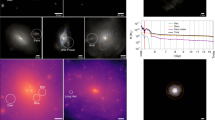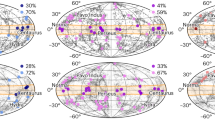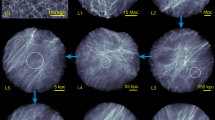Abstract
In cold dark matter cosmological models1,2, structures form and grow through the merging of smaller units3. Numerical simulations have shown that such merging is incomplete; the inner cores of haloes survive and orbit as ‘subhaloes’ within their hosts4,5. Here we report a simulation that resolves such substructure even in the very inner regions of the Galactic halo. We find hundreds of very concentrated dark matter clumps surviving near the solar circle, as well as numerous cold streams. The simulation also reveals the fractal nature of dark matter clustering: isolated haloes and subhaloes contain the same relative amount of substructure and both have cusped inner density profiles. The inner mass and phase-space densities of subhaloes match those of recently discovered faint, dark-matter-dominated dwarf satellite galaxies6,7,8, and the overall amount of substructure can explain the anomalous flux ratios seen in strong gravitational lenses9,10. Subhaloes boost γ-ray production from dark matter annihilation by factors of 4 to 15 relative to smooth galactic models. Local cosmic ray production is also enhanced, typically by a factor of 1.4 but by a factor of more than 10 in one per cent of locations lying sufficiently close to a large subhalo. (These estimates assume that the gravitational effects of baryons on dark matter substructure are small.)
This is a preview of subscription content, access via your institution
Access options
Subscribe to this journal
Receive 51 print issues and online access
$199.00 per year
only $3.90 per issue
Buy this article
- Purchase on Springer Link
- Instant access to full article PDF
Prices may be subject to local taxes which are calculated during checkout



Similar content being viewed by others
References
Peebles, P. J. E. Large-scale background temperature and mass fluctuations due to scale-invariant primeval perturbations. Astrophys. J. 263, L1–L5 (1982)
Blumenthal, G. R., Faber, S. M., Primack, J. R. & Rees, M. J. Formation of galaxies and large-scale structure with cold dark matter. Nature 311, 517–525 (1984)
White, S. D. M. & Rees, M. J. Core condensation in heavy halos - A two-stage theory for galaxy formation and clustering. Mon. Not. R. Astron. Soc. 183, 341–358 (1978)
Ghigna, S. et al. Dark matter haloes within clusters. Mon. Not. R. Astron. Soc. 300, 146–162 (1998)
Klypin, A., Kravtsov, A. V., Valenzuela, O. & Prada, F. Where are the missing galactic satellites? Astrophys. J. 522, 82–92 (1999)
Strigari, L. E. et al. The most dark matter dominated galaxies: Predicted gamma-ray signals from the faintest milky way dwarfs. Astrophys. J. 678, 614–620 (2008)
Simon, J. D. & Geha, M. The kinematics of the ultra-faint milky way satellites: Solving the missing satellite problem. Astrophys. J. 670, 313–331 (2007)
Belokurov, V. et al. Cats and dogs, hair and a hero: A quintet of new milky way companions. Astrophys. J. 654, 897–906 (2007)
Dalal, N. & Kochanek, C. S. Direct detection of cold dark matter substructure. Astrophys. J. 572, 25–33 (2002)
Metcalf, R. B., Moustakas, L. A., Bunker, A. J. & Parry, I. R. Spectroscopic gravitational lensing and limits on the dark matter substructure in Q2237+0305. Astrophys. J. 607, 43–59 (2004)
Green, A. M., Hofmann, S. & Schwarz, D. J. The power spectrum of SUSY-CDM on subgalactic scales. Mon. Not. R. Astron. Soc. 353, L23–L27 (2004)
Diemand, J., Moore, B. & Stadel, J. Earth-mass dark-matter haloes as the first structures in the early Universe. Nature 433, 389–391 (2005)
Stadel, J. G. Cosmological N-body Simulations and Their Analysis. PhD thesis, Univ. Washington. (2001)
Spergel, D. N. et al. Three-year Wilkinson Microwave Anisotropy Probe (WMAP) observations: Implications for cosmology. Astrophys. J. Suppl. Ser 170, 377–408 (2007)
Diemand, J., Kuhlen, M. & Madau, P. Formation and evolution of galaxy dark matter halos and their substructure. Astrophys. J. 667, 859–877 (2007)
Belokurov, V. et al. The field of streams: Sagittarius and its siblings. Astrophys. J. 642, L137–L140 (2006)
Mao, S. & Schneider, P. Evidence for substructure in lens galaxies? Mon. Not. R. Astron. Soc. 295, 587–594 (1998)
Metcalf, R. B. & Madau, P. Compound gravitational lensing as a probe of dark matter substructure within galaxy halos. Astrophys. J. 563, 9–20 (2001)
Zemp, M., Stadel, J., Moore, B. & Carollo, C. M. An optimum time-stepping scheme for N-body simulations. Mon. Not. R. Astron. Soc. 376, 273–286 (2007)
Diemand, J., Moore, B. & Stadel, J. Convergence and scatter of cluster density profiles. Mon. Not. R. Astron. Soc. 353, 624–632 (2004)
Kazantzidis, S. et al. Density profiles of cold dark matter substructure: Implications for the missing-satellites problem. Astrophys. J. 608, 663–679 (2004)
Bullock, J. S. et al. Profiles of dark haloes: evolution, scatter and environment. Mon. Not. R. Astron. Soc. 321, 559–575 (2001)
Ullio, P., Bergström, L., Edsjö, J. & Lacey, C. Cosmological dark matter annihilations into γ rays: A closer look. Phys. Rev. D 66, 123502 (2002)
Colafrancesco, S., Profumo, S. & Ullio, P. Multi-frequency analysis of neutralino dark matter annihilations in the Coma cluster. Astron. Astrophys. 455, 21–43 (2006)
Lavalle, J., Yuan, Q., Maurin, D. & Bi, X. Full calculation of clumpiness boost factors for antimatter cosmic rays in the light of ΛCDM N-body simulation results. Astron. Astrophys. 479, 427–452 (2008)
Beatty, J. J. et al. New measurement of the cosmic-ray positron fraction from 5 to 15GeV. Phys. Rev. Lett. 93, 241102 (2004)
Sharma, S. & Steinmetz, M. Multidimensional density estimation and phase-space structure of dark matter haloes. Mon. Not. R. Astron. Soc. 373, 1293–1307 (2006)
Bertschinger, E. Multiscale Gaussian random fields and their application to cosmological simulations. Astrophys. J. Suppl. Ser. 137, 1–20 (2001)
Navarro, J. F. et al. The inner structure of ΛCDM haloes - III. Universality and asymptotic slopes. Mon. Not. R. Astron. Soc. 349, 1039–1051 (2004)
Reed, D. et al. Dark matter subhaloes in numerical simulations. Mon. Not. R. Astron. Soc. 359, 1537–1548 (2005)
Acknowledgements
It is a pleasure to thank B. Messer and the Scientific Computing Group at the National Center for Computational Sciences for their help. The Via Lactea II simulation was performed at the Oak Ridge National Laboratory through an award from the US Department of Energy’s Office of Science as part of the 2007 Innovative and Novel Computational Impact on Theory and Experiment (INCITE) programme. Additional computations (initial conditions generation, code optimizations and smaller test runs) were carried out on the MareNostrum supercomputer at the BSC, on Columbia at NASA Ames and on the UCSC Astrophysics Supercomputer Pleiades. This work was supported by NASA and the Swiss National Science Foundation.
Author information
Authors and Affiliations
Corresponding author
Supplementary information
Supplementary information
The file contains Supplementary Notes and additional references, Supplementary Figures 1-2 with Legends and Supplementary Table 1. (PDF 118 kb)
Rights and permissions
About this article
Cite this article
Diemand, J., Kuhlen, M., Madau, P. et al. Clumps and streams in the local dark matter distribution. Nature 454, 735–738 (2008). https://doi.org/10.1038/nature07153
Received:
Accepted:
Issue Date:
DOI: https://doi.org/10.1038/nature07153
This article is cited by
-
Dark matter halo mass functions and density profiles from mass and energy cascade
Scientific Reports (2023)
-
Dark matter substructures affect dark matter-electron scattering in xenon-based direct detection experiments
Journal of High Energy Physics (2023)
-
Baryonic solutions and challenges for cosmological models of dwarf galaxies
Nature Astronomy (2022)
-
Chemical and stellar properties of star-forming dwarf galaxies
Nature Astronomy (2022)
-
Stochastic fluctuations of bosonic dark matter
Nature Communications (2021)
Comments
By submitting a comment you agree to abide by our Terms and Community Guidelines. If you find something abusive or that does not comply with our terms or guidelines please flag it as inappropriate.



